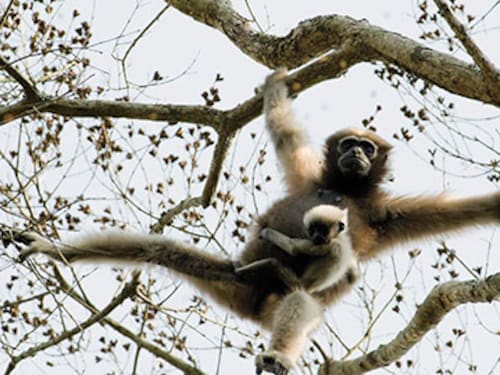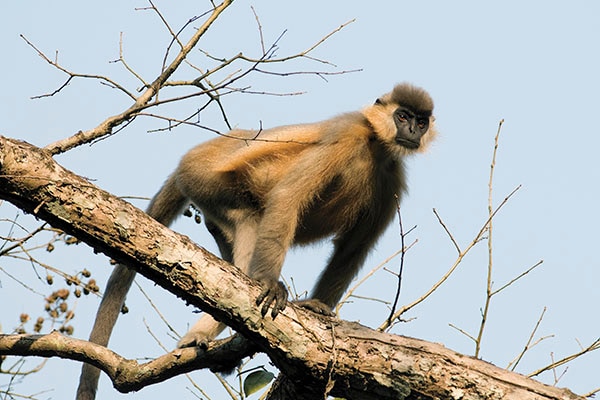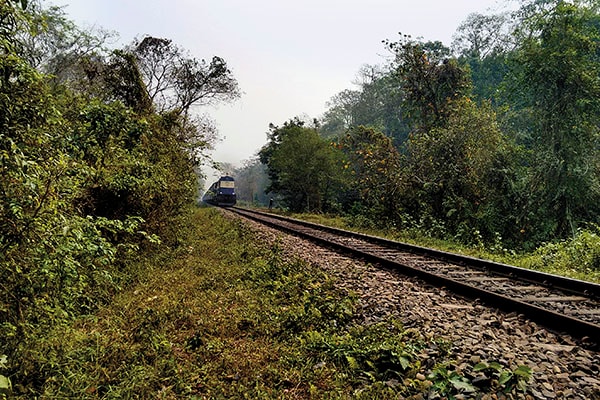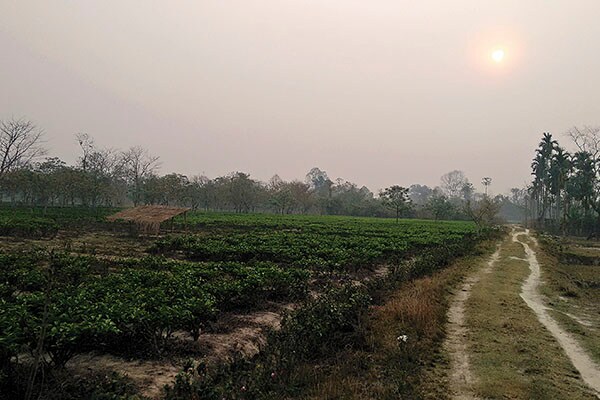Monkey business: The thriving primates of Assam
In this remote part of India, primates, elephants, squirrels and geckos survive train tracks, lost mates and deforestation


An inexplicable ‘kook, kook’ rips through the silence of the night. I am at forest guard Ananto Bohrah’s house, one of the ten that make up a small village in the periphery of Hoollongapar Gibbon Sanctuary, upper Assam. I am here to see the western hoolock gibbon, a graceful and long-limbed arboreal ape that’s native to Northeast India, Bangladesh and parts of Myanmar. The International Union for Conservation of Nature’s (IUCN) Red List of Threatened Species, which categorises the primate as endangered, estimates that only 2,600 western hoolock gibbons are left in India, of which about 2,000 are in Assam.
My travel companion and I had arrived at the sanctuary that evening, having hired an SUV (a Scorpio) and a driver for the 300 km journey from Ziro in Arunachal Pradesh to Mariani, a small Assamese town near the forest reserve. We drove through unpaved mud roads on dried river beds. Where there were no roads, we (along with the SUV) were ferried across the Brahmaputra river, the lifeline of the people of Assam. At Mariani, we resumed our road trip, this time through dirt paths across tea estates that were twinkling with fireflies under the darkening summer sky.
When I finally reach the sanctuary, I am told that the only lodging option, the forest house, has been booked. The officials are polite, but there is no way around the fact that a training programme on the conservation of western hoolock gibbons is underway 20 forest guards from all over the region are stationed in the only two rooms available for guests. The arboreal primate jumps between trees at the Hoollongapar Gibbon Sanctuary in Assam
The arboreal primate jumps between trees at the Hoollongapar Gibbon Sanctuary in Assam
At the urging of his friends, a slightly inebriated Bohrah agrees to host us in his house. The 45-year-old guard seems eager to please, and I don’t register any sinister motive behind his offer. After all, he lives with his family. That’s how I find myself in his house that has bamboo walls coated with rust-coloured mud to ward off insects, a common practice in this region. My companion and I sit in Bohrah’s kerosene-lamp-lit living room his wife, mother and sister squat on the floor pounding betel nuts, all the while attempting to converse in a blend of Assamese and rudimentary Hindi. A full moon lights up the front yard where palm, areca nut and bamboo trees keep watch like silent sentinels.
Kook, kook. I hear it again. “You know what that is?” asks Bohrah. To my untrained ear, it sounds like a lizard. I’m not too far off the mark. “We call it gecko in the local language. People hunt it and sell it for lakhs of rupees,” he tells me. (The lizard, also called gecko in English, is a nocturnal and vocal reptile.) “It has been living in my house for the past few months,” Bohrah adds, implying that he has no intention of trading this particular noisy house guest. I’d later learn that he was referring to the rare and exotic Tokay gecko, found in northeast India. This spotted giant lizard can fetch millions in the black market animal trade because of the (false) belief that it can cure AIDS.
At night, after power is restored in that remote part of Assam, I scan Bohrah’s bare bamboo walls and ceiling inch by inch, but fail to spot the mysterious gecko.
Fortunately, the western hoolock gibbon—not to be confused with the eastern hoolock gibbon that’s found in Arunachal Pradesh—is not as elusive. Next morning, around seven o’clock, when the sun’s rays are slowly warming the tea plantations on the periphery of the sanctuary in Bohrah’s village, we drive along mud-roads that lead to the thickets. In less than 30 minutes, the forest guard shushes me. Gesticulating with his hands, he instructs my companion and me to get out of the SUV and walk into the forest. We follow him noisily as he clears shrubs and bushes from our path, our shoes crunching the bed of leaves and twigs.
Hollong trees, the state tree of Assam from which the sanctuary takes its name, rise above the forest canopy. And there, on one such tree, I spot a slender jet black, long-limbed gibbon. He hangs from his arms tentatively. After having spotted us inching closer to the tree, he swings from branch to branch in a dance-like movement called brachiation. A tuft of white hair around his eyebrows confirms that he is a male western hoolock gibbon. A few trees ahead, a female, her coat a tanned copper unlike the male’s black, looks down at us. She, too, has a white eyebrow band.
Western hoolock gibbons are some of the smallest apes in the world and weigh only 7 kg with little variation between males and females. They can be 20 times smaller than a great ape like a gorilla, which can weigh up to 140 kg. Image: Kevin Schafer / Corbis
Image: Kevin Schafer / Corbis
A capped langur, one of the seven primates that inhabit the Hoollongapar Gibbon Sanctuary
It is a privilege to see not one, but two gibbons. This is one of the rare parts of India where these apes can be found ‘in abundance’. The credit for the conservation programme goes to a joint Indo-US Primate Project, launched in 1994, which was pivotal in identifying the primate diversity in the area, which, at the time, was called Hoollongapar Reserve Forest area. The project spearheaded the primate conservation efforts in India, and its findings also led to the government’s decision to upgrade the region to a sanctuary in 1997. The reserve was renamed Hoollongapar Gibbon Sanctuary. Today, this semi-evergreen forest pocket, south of the Brahmaputra river system, has an area of 21 square km and is home to 106 western hoolock gibbons in 26 groups and five solitary males (as per the sanctuary’s 2009 census). In the 2004 census, there were only 64 western hoolock gibbons in 17 groups.
This is a commendable effort given the odds. On its website, the IUCN writes that there is reason to believe the species has declined by at least 50 percent over the past 40 years (approximately three generations). In an email interview, Dr Narayan Sharma, a research associate with wildlife NGO Nature Conservation Foundation, blames the decimation of gibbons in India’s northeast states on large-scale habitat loss caused by shifting cultivation and the clearance of lowland tropical rainforests for the expansion of tea gardens, agricultural fields and human settlements. “The consequence of habitat loss (primarily due to deforestation) is the fragmentation of the gibbon habitats,” writes Sharma, who studies community, behavioural ecology and conservation biology of the primates in the fragmented landscape of the Brahmaputra valley.
According to Sharma, the second-most important threat comes from tribals who depend on the forest for subsistence. A penchant for hunting among the tribes severely affects the gibbon population. Though they are hunted for meat, in some places the apes are also hunted for medicinal purposes. Women in Ngopa village adjacent to the Lengteng Wildlife Sanctuary in Mizoram, for instance, wear gibbon bones on their feet. They believe the bone of the gibbon can cure gout and other inflammatory problems.
India’s northeast has the highest primate diversity in the country and is home to as many as 11 of a total of 22 species. The Hoollongapar Gibbon Sanctuary has seven primate species including the slow loris, stump-tailed macaque, Assamese macaque, rhesus macaque, northern pig-tailed macaque, capped langur, and the western hoolock gibbon . Bohrah, who turns out to be an excellent spotter with a keen ear for animal calls, helps me identify some of these primates. I follow him down a pathway colonised by wild forest plants crowned with soft blue flowers on each side. In this wild and remote part of India, the forest guard in his khaki garb—and armed with a gun—is a symbol of authority. We see Malayan giant squirrels feasting on fruit, sitting on tree branches, their furry tails hanging like black brushes.
As the soft, early morning sun slowly becomes harsher, raising the humidity level in the air a notch higher, we bump into Bohrah’s colleague who is on his morning patrol. “Show them the pig-tailed macaques,” he says, after spotting a pack a few feet away. We take a slight diversion into a tertiary path and walk deeper into the forest to see the pack of pig-tailed macaques. True to their moniker, their stubby tails look like they belong to a pig’s body, but arching backward. A baby in the pack looks down at us before sprinting further up the tree. Image: Prathap Nair
Image: Prathap Nair
The train line that slices through the sanctuary
It’s now noon, five hours since we left the village, and we have moseyed towards a train track that slices through the sanctuary. Trains screeching and huffing in the heart of forest land are part of Assam’s landscape, and a major cause for mortality and injury to wild animals. In November 2013, a herd of 40 elephants was killed in Assam when a train mowed them down.
The indirect impact of these tracks is also lethal: They are blamed for habitat fragmentation, and preventing native wild animals like gibbons and stump-tailed macaques from accessing their abodes easily. I am told that this particular train track has been running through the sanctuary since 1881, and was constructed during the Raj to transport coal, tea and oil from Assam to the rest of the country. The canopy gap—the result of deforestation to lay the track—exists to this day, 134 years later.
Gibbons are almost exclusively arboreal and seldom descend to the ground, and need continuous forest cover to move freely. Even a small gap in the canopy hinders their movement. But because of train tracks and deforestation, most of the gibbon populations in the northeast are trapped in small forest fragments where they are vulnerable to
local extinction.
In a particularly melancholic post on the Nature Conservation Foundation India blog, Sharma writes about how a railway track permanently estranged a female stump-tailed macaque from her pack: “She saw two long ‘poles’ lying parallel to each other on a raised platform all along the clearing as far as her eyes could see. Their forest was neatly sliced into two unequal parts. She would never forget the day when a moving beast whizzed past her with a deafening sound, leaving a trail of black smoke hovering over the forest.”
As we walk further down the track, we run into the training party of forest guards who are recording the sightings of primates. The week-long residential training, conducted by the Assam-based environmental NGO Aaranyak is titled ‘Training of Forest Guards for the Conservation of Hoolock Gibbon in Assam’. The 20 participants, forest guards from various regions in Assam, are being trained on topics with special reference to gibbon conservation. These include population estimation, habitat characteristics and restoration, habitat monitoring, rescue and rehabilitation, the use of global positioning systems (GPS), wildlife laws and their application and the role of local communities in conservation.
I strike up a conversation with the guards, and keep pace with them as they mark the GPS coordinates of every primate that they spot. I see another juvenile male hoolock gibbon, swinging on a tree, from branch to slender branch. “This little fellow is lonely because his prospective bride is on the other side of the track. And he cannot cross over the tracks because he is arboreal,” says Jeevan Bohra, an associate with Aaranyak who is accompanying the forest guards on the training programme.  Image: Prathap Nair
Image: Prathap Nair
The flat tea plantations on the plains inside the sanctuary
Gibbons follow a strictly monogamous social structure with an adult male and female staying together for their whole lives. They do not mate within families. The adolescent male on the tree is lovelorn, insists Jeevan. The animal in question, however, doesn’t look too heartbroken and is bearing the enforced separation with fortitude. He is happily selecting and munching on flower buds and shoots from a tree. (A western hoolock gibbon’s diet consists primarily of berries, leaves, flowers and buds.)
But if conservation efforts go as planned, he will be united with his bride. To enable arboreal animals to cross to the other side, the forest department wants to plant tall bamboos on either side of the tracks. Officials are hoping that the slender but soaring bamboos will form canopy bridges for gibbons, enabling them to seamlessly roam on both sides of the railway track. Their optimism is buoyed by the fact that gibbons have been observed using such bamboo canopy bridges by researchers in Bherjan-Borajan-Padumoni Wildlife Sanctuary in the Tinsukia district of Assam.
While the forest guards continue with their census, I squat on the tracks, thirsty and perspiring in the humid and clammy weather. The playful juvenile is still swinging from branch to branch like an acrobat. He occasionally looks down at the people below who are pointing instruments (cameras) that go ‘click’, ‘click’ at him. Oblivious to the threat his species faces, his ‘hooku hooku’ fills the muggy air of the forest canopy. As I retrace my steps back to the SUV, I hope he finds his way back to his mate.
First Published: Aug 27, 2015, 06:27
Subscribe Now(This story appears in the Jul 16, 2010 issue of Forbes India. To visit our Archives, Click here.)